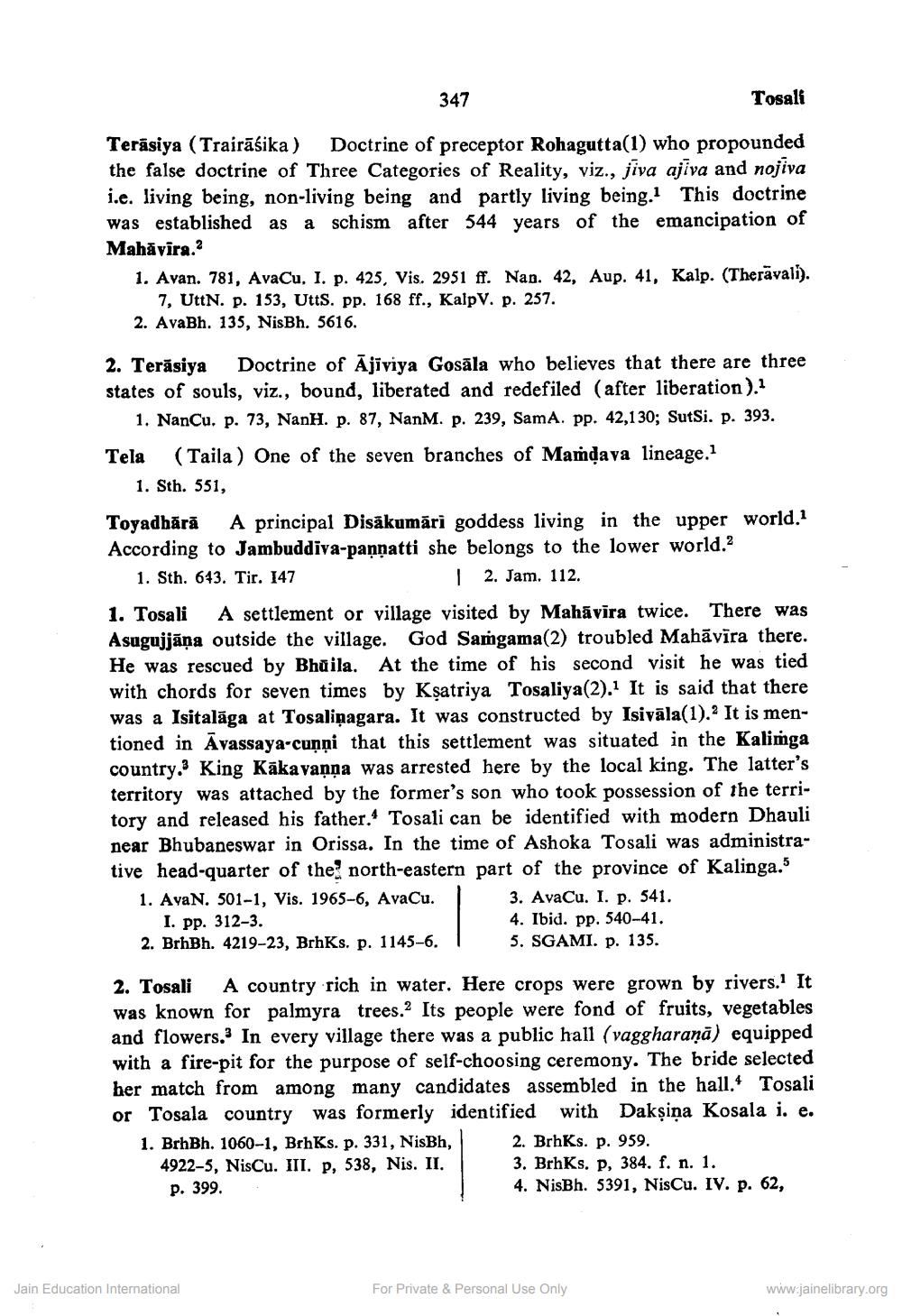________________
347
Tosali
Teräsiya (Trairāśika) Doctrine of preceptor Rohagutta(1) who propounded the false doctrine of Three Categories of Reality, viz., jiva ajiva and nojiva i.e. living being, non-living being and partly living being. This doctrine was established as a schism after 544 years of the emancipation of Mahăvira. 1. Avan. 781, AvaCu, I. p. 425, Vis. 2951 ff. Nan. 42, Aup. 41, Kalp. (Therävali).
7, UttN. p. 153, Utts. pp. 168 ff., KalpV. p. 257. 2. AvaBh. 135, NisBh. 5616.
2. Terăsiya Doctrine of Ājiviya Gosāla who believes that there are three states of souls, viz., bound, liberated and redefiled (after liberation).
1. NanCu. p. 73, NanH. p. 87, NanM. p. 239, SamA. pp. 42,130; SutSi. p. 393. Tela (Taila) One of the seven branches of Mamdava lineage.1
1. Sth. 551, Toyadbārā A principal Disākumāri goddess living in the upper world. According to Jambuddiva-paņnatti she belongs to the lower world.2 1. Sth. 643. Tir. 147
12. Jam. 112. 1. Tosali A settlement or village visited by Mahāvīra twice. There was Asugujjāņa outside the village. God Samgama(2) troubled Mahāvīra there. He was rescued by Bhūila. At the time of his second visit he was tied with chords for seven times by Ksatriya Tosaliya(2).1 It is said that there was a Isitalāga at Tosaliņagara. It was constructed by Isivāla(1). It is mentioned in Avassaya-cuni that this settlement was situated in the Kalimga country. King Kākavanna was arrested here by the local king. The latter's territory was attached by the former's son who took possession of the territory and released his father.' Tosali can be identified with modern Dhauli near Bhubaneswar in Orissa. In the time of Ashoka Tosali was administrative head-quarter of the north-eastern part of the province of Kalinga.5 1. AvaN. 501-1, Vis. 1965-6, AvaCu. 3. AvaCu. I. p. 541. I. pp. 312-3.
4. Ibid. pp. 540-41. 2. BrhBh. 4219-23, BrhKs. p. 1145-6. 5. SGAMI. p. 135.
2. Tosali A country rich in water. Here crops were grown by rivers. It was known for palmyra trees. Its people were fond of fruits, vegetables and flowers. In every village there was a public hall (vaggharaņā) equipped with a fire-pit for the purpose of self-choosing ceremony. The bride selected her match from among many candidates assembled in the hall. Tosali or Tosala country was formerly identified with Dakşina Kosala i. e. 1. BrhBh. 1060-1, BrhKs. p. 331, NisBh, 2. BrhKs. p. 959. 4922-5, NisCu. III. p, 538, Nis. II. 3. BrhKs. P, 384. f. n. 1. p. 399.
4. NisBh. 5391, NisCu. IV. p. 62,
Jain Education International
For Private & Personal Use Only
www.jainelibrary.org




